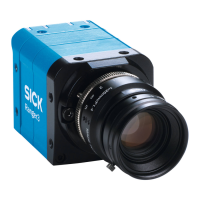In HDR mode, the sensor readout must be finished before a new exposure can start.
The sensor readout time is the time the sensor needs for the readout of the collected
data. The minimum cycle time is the sum of the exposure time and the readout time. In
linear mode, the sensor readout and a new exposure can be done in parallel.
For example: If the readout time is 33 μs and the exposure time is 30 μ, the total cycle
time is 33 μs for linear mode and 63 μs for HDR, giving a maximum timed profile rate
of 30 kHz and 16 kHz respectively.
For information about how to enable HDR imaging for Ranger3, see "Enabling HDR
imaging", page 65.
8.10 Triggering
Triggering is used to control the initiation and rate of data acquisition. Different trigger‐
ing concepts and modes are presented below.
See "Setting triggering parameters", page 65 for information about how to activate
triggering and set the parameters in the user interface.
8.10.1 3D triggering concepts
Different application types require different triggering concepts. Below is a table of the
most common triggering situations.
Continuous flow No photoelectric sensor is used.
Profiles are sent continuously to the PC, typically
arranged in images of at least a few hundred pro‐
files.
Examples: Crushed stone, grain, sawdust.
Continuous flow
of discrete
objects
No photoelectric sensor is used.
Profiles are sent continuously to the PC, typically
arranged in images of at least a few hundred pro‐
files.
The resulting image buffers on the PC can be ana‐
lyzed in a rolling buffer fashion, ensuring that all
objects are analyzed completely.
Example: Cookies.
Shorter objects
of equal length
A photoelectric sensor is used.
One image per object.
Examples: Bottles, automotive parts, mobile
phones.
Longer objects of
variable size
A photoelectric sensor is used.
Acquire profiles as long as the object remains in
front of the camera.
Several sub-images can be stitched together on the
PC.
Examples: Logs, fish, postal packages.
8.10.2 Triggering modes
There are different ways to trigger the camera to acquire frames and profiles. You can
use an external signal to trigger each frame or each single profile. The camera can
also be configured to acquire frames or profiles with regular time intervals, without an
external trigger signal.
CONFIGURATION 8
8020774/1D7Q/2022-03 | SICK O P E R A T I N G I N S T R U C T I O N S | Ranger3
45
Subject to change without notice

